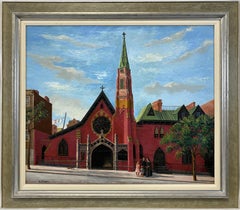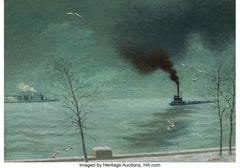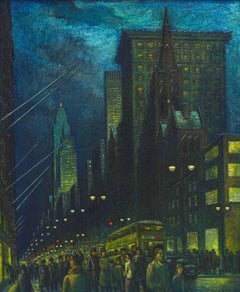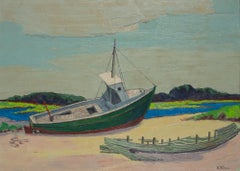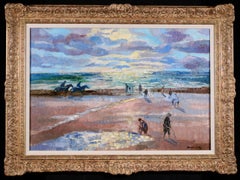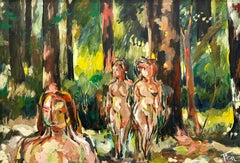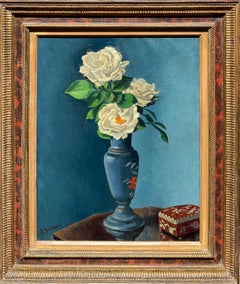Ernest Fiene Paintings
to
1
1
1
3
4
Overall Width
to
Overall Height
to
9
3
3
2
5
2
5
4
5
3
3
3
2
2
2
1
1
1
1
1
1
1
1
1
1
1
1
1
9
9
8
8
1
10
780
721
710
686
9
9
Artist: Ernest Fiene
NYC Cityscape American Scene WPA Modern Realism Mid 20th Century Architectural
By Ernest Fiene
Located in New York, NY
NYC Cityscape American Scene WPA Modern Realism Mid 20th Century Architectural
Ernest Fiene (1894-1965)
Cityscape
36 x 30 inches
Oil on canvas
Signed and dated 1930. lower right
Provenance
Estate of the artist.
ACA Galleries, New York
Exhibited
New York, Frank Rehn Gallery, Changing Old New York, 1931.
New York, ACA Galleries, Ernest Fiene: Art of the City, 1925-1955, May 2-23, 1981, n.p., no. 5.
BIO
Ernest Fiene was born in Elberfeld, Germany in 1894. As a teenager, Fiene immigrated to the United States in 1912. He studied art at the National Academy of Design in New York City from 1914 to 1918, taking day classes with Thomas Maynard and evening classes with Leon Kroll. Fiene continued his studies at the Beaux-Arts Institute of Design in New York from 1916 to 1918, adding classes in printmaking at the Art Students League in 1923.
Fiene began his career as an artist in 1919 with his first exhibition of watercolors at the MacDowell Club arranged by his mentor Robert Henri. In 1923 the Whitney Studio Club mounted a large exhibition of his works. The following year he had an exhibition at the New Gallery in New York, which completely sold out all fifty-two works, including paintings, watercolors, drawings, and etchings. With the proceeds of sales from the New Gallery exhibition, Ernest Fiene and his younger brother Paul, a sculptor, built studios in Woodstock, New York in 1925.
In the early Twenties Ernest Fiene painted mostly landscapes of Woodstock and both the Ramapo and Hudson River Valleys. The first monograph from the Younger Artists Series was published on Fiene in 1922. Published in Woodstock, the series went on to include Alexander Brook, Peggy Bacon, and Yasuo Kuniyoshi. The book reproduced 1 illustration in color and another 27 reproductions in black and white. Around 1925 Fiene became fascinated with the intensity, excitement, and opportunities for color harmonies New York City offered as a subject. His paintings shifted to urban and industrial themes with architecture, industry, and transportation becoming his subjects.
By 1926 Fiene had attracted the dealer Frank K.M. Rehn, who gave him a one-man exhibition that year, which travelled to the Boston Arts Club. C.W. Kraushaar Galleries gave Fiene a one-man exhibition of urban, landscape, portrait, and still life paintings in 1927. Julianna Force, the director of the Whitney Studio Club and first director of the Whitney Museum of American Art, included two of Fiene’s paintings in a fall exhibition in 1928. The Whitney Studio Club showed Fiene’s paintings in a two-man exhibition with Glenn O. Coleman that year and acquired three of Fiene’s paintings. Also in 1928 Fiene became affiliated with Edith Halpert’s Downtown Gallery where he had an exhibition of 20 lithographs in the spring. Fiene sold his house in Woodstock in 1928 to spend more of his time in New York City.
With so many successful exhibitions, Fiene returned to Paris in 1928-29 where he rented Jules Pascin's studio and studied at the Académie de la Grande Chaumière. In France, Fiene painted both landscape and urban subjects developed from ideas influenced by Cubist geometry and the use of flat areas of broad color. Upon returning to New York in 1930, Fiene used this new approach to continue to paint New York skyscraper and waterfront subjects, as well as to begin a series of paintings on changing old New York based on the excavations for Radio City Music Hall and the construction of the Empire State Building. Frank K.M. Rehn Galleries exhibited this series, titled “Changing Old New York,” in 1931. Fiene also has solo exhibitions at Rehn Galleries in 1930 and 1932. Fiene’s oil paintings are exhibited at the Chicago Arts Club in 1930 as well.
Fiene was included in the Museum of Modern Art’s exhibition Painting and Sculpture by Living Americans in December of 1931. Visiting New York, Henri Matisse saw the exhibition and called Fiene’s Razing Buildings, West 49th Street the finest painting he had seen in New York. Fiene had two mural studies from his Mechanical Progress series exhibited at the Museum of Modern Art’s exhibition Murals by American Painters and Photographers in 1932. Fiene sent View from my Window which depicts Fiene working on a lithograph stone while looking out his window to the newly completed Empire State Building to the Carnegie International in 1931. In 1932 Fiene participated in the first Biennial of American Painting at the Whitney Museum and his prints were included in exhibitions at the Downtown Gallery and the Wehye Gallery. In the same year, Fiene was awarded a Guggenheim fellowship to further study mural painting in Florence, Italy.
On his return from Italy in 1933 Fiene re-engaged himself in New York City life and won several public and private mural projects. Fiene resumed his active exhibition schedule, participating in two group exhibitions at the Whitney Museum and a one-man exhibition of recent paintings at the Downtown Gallery in January 1934. In 1933 he purchased a farm in Southbury, Connecticut, which added Connecticut scenes to his landscape subjects. This was also the year Fiene began to spend summers on Monhegan Island, Maine, where he painted seascapes, harbor scenes, and still lifes.
Fiene’s landscape paintings attracted numerous commissions as part of the American Scene movement. Through the fall and winter of 1935-36, Fiene took an extended sketching trip through the urban, industrial, and farming areas of Pennsylvania and West Virginia. Most of the twenty-four Pennsylvania urban and rural paintings...
Category
1930s American Modern Ernest Fiene Paintings
Materials
Canvas, Oil
"St. Michael’s in Brooklyn", New York City Street Scene, Cityscape, Brick Church
By Ernest Fiene
Located in Yardley, PA
“St. Michael’s in Brooklyn, c. 1944” by Ernest Fiene (1894-1965)
New York City served as an endless source of inspiration for Fiene, who often captured street scenes like this one i...
Category
1940s American Modern Ernest Fiene Paintings
Materials
Canvas, Oil
"Tugboat in New York Harbor" Ernest Fiene, Modernist, Cerulean Waterscape
By Ernest Fiene
Located in New York, NY
Ernest Fiene
Tugboat in New York Harbor
Signed lower right
Oil on canvas
24 1/2 x 34 1/2 inches
Ernest Fiene was born in Elberfeld, Germany in 1894. As a teenager, Fiene immigrated...
Category
1930s American Modern Ernest Fiene Paintings
Materials
Canvas, Oil
"Glassblowers" American Scene Social Realism Mid-20th Century New York City WPA
By Ernest Fiene
Located in New York, NY
"Glassblowers" American Scene Social Realism Mid-20th Century New York City WPA
Ernest Fiene (1894-1965)
Glass Blowers
28 x 23 inches
Oil on canvas board
Signed and dated 1944 lower...
Category
1940s American Modern Ernest Fiene Paintings
Materials
Oil, Canvas
Winter Evening Fifth Avenue Nocturne - New York at Night
By Ernest Fiene
Located in Miami, FL
Ernest Fiene depicts Fifth Avenue, looking down from 57th Street, with an unobstructed view of the Empire State Building, as an evocation of night. The artist captures a dark, moody blue sky, with light bouncing back from the clouds. This contrasts with the somewhat haunting yellow glow given to pedestrians and street traffic. The absence of newer glass-and-steel architecture provides the painting with the charm of old New York. The people have a slightly zombie-like quality, akin to George Tooker. Best viewed with a top and direct gallery light...
Category
1950s Post-Impressionist Ernest Fiene Paintings
Materials
Canvas, Oil
"Low Tide at Noon, Wellfleet, Massachusetts, " Ernest Fiene, WPA, Boat on Beach
By Ernest Fiene
Located in New York, NY
Ernest Fiene (1894 - 1965)
Low Tide at Noon, Wellfleet, Massachusetts
Oil on canvas
26 x 36 inches
Signed lower right
Ernest Fiene was born in Elberfeld, Germany in 1894. As a teenager, Fiene immigrated to the United States in 1912. He studied art at the National Academy of Design in New York City from 1914 to 1918, taking day classes with Thomas Maynard and evening classes with Leon Kroll. Fiene continued his studies at the Beaux-Arts Institute of Design in Paris from 1916 to 1918, adding classes in printmaking at the Art Students League in 1923.
Fiene began his career as an artist in 1919 with his first exhibition of watercolors at the MacDowell Club arranged by his mentor Robert Henri. In 1923 the Whitney Studio Club mounted a large exhibition of his works. The following year he had an exhibition at the New Gallery in New York, which completely sold out all fifty-two works, including paintings, watercolors, drawings, and etchings. With the proceeds of sales from the New Gallery exhibition, Ernest Fiene and his younger brother Paul, a sculptor, built studios in Woodstock, New York in 1925.
In the early Twenties Ernest Fiene painted mostly landscapes of Woodstock and both the Ramapo and Hudson River Valleys. He was the subject of the first monograph for the Younger Artists Series in 1922. Published in Woodstock, the series went on to include Alexander Brook, Peggy Bacon, and Yasuo Kuniyoshi. The book reproduced 1 illustration in color and another 27 reproductions in black and white. Around 1925 Fiene became fascinated with the intensity, excitement, and opportunities for color harmonies New York City offered as a subject. His paintings shifted to urban and industrial themes with architecture, industry, and transportation becoming his subjects.
By 1926 Fiene had attracted the dealer Frank K.M. Rehn, who gave him a one-man exhibition that year, which travelled to the Boston Arts Club. C.W. Kraushaar Galleries gave Fiene a one-man exhibition of urban, landscape, portrait, and still life paintings in 1927. Julianna Force, the director of the Whitney Studio Club and first director of the Whitney Museum of American Art, included two of Fiene's paintings in a fall exhibition in 1928. The Whitney Studio Club showed Fiene's paintings in a two-man exhibition with Glenn O. Coleman that year and acquired three of Fiene's paintings. Also in 1928 Fiene became affiliated with Edith Halpert's Downtown Gallery where he had an exhibition of 20 lithographs in the spring. Fiene sold his house in Woodstock in 1928 to spend more of his time in New York City.
With so many successful exhibitions, Fiene returned to Paris in 1928-29 where he rented Jules Pascin's studio and studied at the Académie de la Grande Chaumière. In France, Fiene painted both landscape and urban subjects developed from ideas influenced by Cubist geometry and the use of flat areas of broad color. Upon returning to New York in 1930, Fiene used this new approach to continue to paint New York skyscraper and waterfront subjects, as well as to begin a series of paintings on changing old New York based on the excavations for Radio City Music Hall and the construction of the Empire State Building. Frank K.M. Rehn Galleries exhibited this series, titled "Changing Old New York," in 1931. Fiene also has solo exhibitions at Rehn Galleries in 1930 and 1932. Fiene's oil paintings are exhibited at the Chicago Arts Club in 1930 as well.
Fiene was included in the Museum of Modern Art's exhibition Painting and Sculpture by Living Americans in December of 1931. Visiting New York, Henri Matisse saw the exhibition and called Fiene's Razing Buildings, West 49th Street the finest painting he had seen in New York. Fiene had two mural studies from his Mechanical Progress series exhibited at the Museum of Modern Art's exhibition Murals by American Painters and Photographers in 1932. Fiene sent View from my Window which depicts Fiene working on a lithograph stone while looking out his window to the newly completed Empire State Building to the Carnegie International in 1931. In 1932 Fiene participated in the first Biennial of American Painting at the Whitney Museum and his prints were included in exhibitions at the Downtown Gallery and the Wehye Gallery. In the same year, Fiene was awarded a Guggenheim fellowship to further study mural painting in Florence, Italy.
On his return from Italy in 1933 Fiene re-engaged himself in New York City life and won several public and private mural projects. Fiene resumed his active exhibition schedule, participating in two group exhibitions at the Whitney Museum and a one-man exhibition of recent paintings at the Downtown Gallery in January 1934. In 1933 he purchased a farm in Southbury, Connecticut, which added Connecticut scenes to his landscape subjects. This was also the year Fiene began to spend summers on Monhegan Island, Maine, where he painted seascapes, harbor scenes, and still lifes.
Fiene's landscape paintings attracted numerous commissions as part of the American Scene movement. From 1935-36 Fiene took an extended sketching trip through the urban, industrial, and farming areas of Pennsylvania and West Virginia. Most of the twenty-four Pennsylvania urban and rural paintings from this trip were featured in an exhibition held at the First National Bank in Pittsburgh in October of 1937 by the Pittsburgh Commission for Industrial Expansion. Fiene said of these works that he formed rhythm, opportunity for space and color, and integrity in the Pennsylvania mill and furnace paintings. Fiene received the silver medal for one of the Pittsburgh paintings...
Category
Mid-20th Century American Realist Ernest Fiene Paintings
Materials
Canvas, Oil
"6th Avenue El" American Scene Social Realism Mid-20th Century New York City
By Ernest Fiene
Located in New York, NY
"6th Avenue El" American Scene Social Realism Mid-20th Century New York City
Ernest Fiene (1894-1965)
"6th Avenue El"
12 1/4 x 14 1/4
Oil on canvas board, c. 1940s
Signed lower righ...
Category
1940s American Modern Ernest Fiene Paintings
Materials
Oil, Board
"Along the Kanahawa River, West Virginia, " Ernest Fiene, WPA Coal Steamboat
By Ernest Fiene
Located in New York, NY
Ernest Fiene
Along the Kanahawa River, West Virginia, 1936
Signed lower right
Oil on canvas
26 x 36 inches
Fiene made a series of paintings, drawings and lithographs which are based on his travels through Pennsylvania and West Virginia during the winter of 1935-36. The industrial areas of Pennsylvania and West Virginia are represented in numerous oils, among which are some of his most well-known. Fiene wrote of the trip, "The increasing snow and atmospheric conditions [in the Kanawha River valley} enhanced this mountainous coal mining country with a majestic beauty."
Winter on the River is Fiene's only American Artists Group print and there were only two lithographs produced from the West Virginia trip. The American Artists Group (AAG), under the direction of Carl Zigrosser, who was then working at New York's famed Weyhe Gallery, published ninety-three prints by over fifty artists in 1936 and 1937. Zigrosser's goal was to popularize contemporary American art through original prints offered at the low price of $2.75. The project was also a means to provide income for impoverished artists during the Depression. The prints were featured in many of the leading print exhibitions and publications of the period. The lithograph produced from this image is now in the collection of the Amon Carter Museum, Baltimore Museum of Art, Cleveland Museum of Art, Philadelphia Museum of Art, Pensacola Museum of Art, San Francisco Fine Arts Museum, Syracuse Museum, Yale University Art Museum.
Ernest Fiene was born in Elberfeld, Germany in 1894. As a teenager, Fiene immigrated to the United States in 1912. He studied art at the National Academy of Design in New York City from 1914 to 1918, taking day classes with Thomas Maynard and evening classes with Leon Kroll. Fiene continued his studies at the Beaux-Arts Institute of Design in New York from 1916 to 1918, adding classes in printmaking at the Art Students League in 1923.
Fiene began his career as an artist in 1919 with his first exhibition of watercolors at the MacDowell Club arranged by his mentor Robert Henri. In 1923 the Whitney Studio Club mounted a large exhibition of his works. The following year he had an exhibition at the New Gallery in New York, which completely sold out all fifty-two works, including paintings, watercolors, drawings, and etchings. With the proceeds of sales from the New Gallery exhibition, Ernest Fiene and his younger brother Paul, a sculptor, built studios in Woodstock, New York in 1925.
In the early Twenties Ernest Fiene painted mostly landscapes of Woodstock and both the Ramapo and Hudson River Valleys. The first monograph from the Younger Artists Series was published on Fiene in 1922. Published in Woodstock, the series went on to include Alexander Brook, Peggy Bacon, and Yasuo Kuniyoshi. The book reproduced 1 illustration in color and another 27 reproductions in black and white. Around 1925 Fiene became fascinated with the intensity, excitement, and opportunities for color harmonies New York City offered as a subject. His paintings shifted to urban and industrial themes with architecture, industry, and transportation becoming his subjects.
By 1926 Fiene had attracted the dealer Frank K.M. Rehn, who gave him a one-man exhibition that year, which travelled to the Boston Arts Club. C.W. Kraushaar Galleries gave Fiene a one-man exhibition of urban, landscape, portrait, and still life paintings in 1927. Julianna Force, the director of the Whitney Studio Club and first director of the Whitney Museum of American Art, included two of Fiene’s paintings in a fall exhibition in 1928. The Whitney Studio Club showed Fiene’s paintings in a two-man exhibition with Glenn O. Coleman that year and acquired three of Fiene’s paintings. Also in 1928 Fiene became affiliated with Edith Halpert’s Downtown Gallery where he had an exhibition of 20 lithographs in the spring. Fiene sold his house in Woodstock in 1928 to spend more of his time in New York City.
With so many successful exhibitions, Fiene returned to Paris in 1928-29 where he rented Jules Pascin's studio and studied at the Académie de la Grande Chaumière. In France, Fiene painted both landscape and urban subjects developed from ideas influenced by Cubist geometry and the use of flat areas of broad color. Upon returning to New York in 1930, Fiene used this new approach to continue to paint New York skyscraper and waterfront subjects, as well as to begin a series of paintings on changing old New York based on the excavations for Radio City Music Hall and the construction of the Empire State Building. Frank K.M. Rehn Galleries exhibited this series, titled “Changing Old New York,” in 1931. Fiene also has solo exhibitions at Rehn Galleries in 1930 and 1932. Fiene’s oil paintings are exhibited at the Chicago Arts Club in 1930 as well.
Fiene was included in the Museum of Modern Art’s exhibition Painting and Sculpture by Living Americans in December of 1931. Visiting New York, Henri Matisse saw the exhibition and called Fiene’s Razing Buildings, West 49th Street the finest painting he had seen in New York. Fiene had two mural studies from his Mechanical Progress series exhibited at the Museum of Modern Art’s exhibition Murals by American Painters and Photographers in 1932. Fiene sent View from my Window which depicts Fiene working on a lithograph stone while looking out his window to the newly completed Empire State Building to the Carnegie International in 1931. In 1932 Fiene participated in the first Biennial of American Painting at the Whitney Museum and his prints were included in exhibitions at the Downtown Gallery and the Wehye Gallery. In the same year, Fiene was awarded a Guggenheim fellowship to further study mural painting in Florence, Italy.
On his return from Italy in 1933 Fiene re-engaged himself in New York City life and won several public and private mural projects. Fiene resumed his active exhibition schedule, participating in two group exhibitions at the Whitney Museum and a one-man exhibition of recent paintings at the Downtown Gallery in January 1934. In 1933 he purchased a farm in Southbury, Connecticut, which added Connecticut scenes to his landscape subjects. This was also the year Fiene began to spend summers on Monhegan Island, Maine, where he painted seascapes, harbor scenes, and still lifes.
Fiene’s landscape paintings attracted numerous commissions as part of the American Scene movement. Through the fall and winter of 1935-36, Fiene took an extended sketching trip through the urban, industrial, and farming areas of Pennsylvania and West Virginia. Most of the twenty-four Pennsylvania urban and rural paintings from this trip were featured in an exhibition held at the First National Bank in Pittsburgh in October of 1937 by the Pittsburgh Commission for Industrial Expansion. Fiene said of these works that he formed rhythm, opportunity for space and color, and integrity in the Pennsylvania mill and furnace paintings. Fiene received the silver medal for one of the Pittsburgh paintings...
Category
1930s American Realist Ernest Fiene Paintings
Materials
Canvas, Oil
$8,000 Sale Price
20% Off
Winter Evening Fifth Avenue - New York at Night - Mid-Century.
By Ernest Fiene
Located in Miami, FL
Mid-century New York City is represented as a moment in time. The artist populates his scene with isolated figures that are more shapes of people as opposed to specific individuals....
Category
1950s Post-Impressionist Ernest Fiene Paintings
Materials
Canvas, Oil
Related Items
Coucher de Soleil - Post Impressionist Figurative Oil by Emilio Grau Sala
By Emilio Grau Sala
Located in Marlow, Buckinghamshire
Signed oil on canvas by Spanish post impressionist painter Emilio Grau Sala. The work depicts beachgoers in Deauville, France taking the last of the sun as it disappears beyond the horizon. The pale yellow light reflects on the sea, illuminating the water. Two horse riders gallop across the sand. The piece is painted in beautiful shades.
Signature:
Signed lower right and further signed and titled verso
Dimensions:
Framed: 27"x36"
Unframed: 20"x29"
Provenance:
Private Collection - France
Emilio Grau Sala studied at the fine arts school in Barcelona, where he became friends with Antoni Clavé. While still very young he began exhibiting at the Humourists Exhibition. In Paris he exhibited at the major annual Salons. He also exhibited at many international group exhibitions and in 1937 received an important award at the Carnegie Foundation International Exhibition in Pittsburgh. He showed collections of his work in many solo exhibitions starting in Barcelona in 1929 and 1930. His first solo exhibition in Paris was in 1937 and he went on to exhibit in Madrid, London, Buenos Aires and New York. After three trips to Paris he finally settled there in 1936.
In Paris he was influenced by the paintings of Marcel Gromaire and especially Julius Pascin. He created theatrical sets and costumes for several plays including The Woman of Easy Virtue ( La Demoiselle de Petite Vertu) by Marcel Achard. He also illustrated many literary works including Madame Bovary by Flaubert, Bel-Ami by Maupassant, Colette's series of four Claudine novels, Marcel Proust's In Search of Lost Time ( À la Recherche du Temps Perdu), and works by poets including Baudelaire's Les Fleurs du Mal...
Category
1950s Post-Impressionist Ernest Fiene Paintings
Materials
Oil, Canvas
A Large, Dynamic Mid-Century Modern Figurative Landscape Painting by Rudolph Pen
Located in Chicago, IL
A large, dynamic Mid-Century Modern summer landscape painting with standing female bathers by noted Chicago artist, Rudolph Pen. A wonderful example of the artist's uniquely express...
Category
Mid-20th Century American Modern Ernest Fiene Paintings
Materials
Canvas, Oil
$2,800
H 36 in W 50 in D 2 in
"Winter" American Modernism WPA Regionalism Landscape Mid-Century Magic Realism
By Dale Nichols
Located in New York, NY
"Winter" American Modernism WPA Regionalism Landscape Mid-Century Magic Realism. 30 x 40 inches. Oil on canvas, c. 1960s, Signed lower right.
As we list the painting now, the work is currently being cleaned, restored and a hand carved frame is being built. Additional photos will be uploaded as soon as possible.
Our gallery, Helicline Fine Art, just launched our new digital exhibition: American Art: The WPA and Beyond. Three dozen paintings, works on paper and sculptures which are available here on 1stDibs. In person viewings can be arranged by appointment at our midtown Manhattan gallery.
Provenance:
"Winter" was originally purchased by Stanley Byer. Mr. Byer owned homes in Key West, New York City, and Washington, D.C. He purchased the painting from Dunning Auction in 1984 in Elgin, Illinois. Mr. Byer was related to Abraham Weiss from Florida. Saul Babbin, now deceased was a cousin of Mr. Weiss. I purchased the painting from Joy Babbin, Mr. Babbin's wife, now living in from New Mexico.
Dale Nichols (1905 – 1995) Artist, printmaker, illustrator, watercolorist, designer, writer and lecturer, Nichols did paintings that reflected his rural background of Nebraska where he was born in David City, a small town. Although he did much sketching outdoors, most of his paintings were completed in his studio and often included "numerology, magic squares...
Category
1960s American Modern Ernest Fiene Paintings
Materials
Canvas, Oil
$95,000
H 38 in W 48 in D 2 in
Scintillating Light: View from the Hills to the City, a winding path, Madrid
Located in Norwich, GB
A perfectly Impressionistic work with beautifully loose, almost pointillist brushstrokes, focussing on the scintillating light and the remote hilltop atmosphere.
Artist Frans Hog...
Category
1910s Pointillist Ernest Fiene Paintings
Materials
Canvas, Oil, Board
$1,400
H 14.97 in W 19.3 in D 1.19 in
Landscape with castle oil on canvas painting
By Rafael Griera Calderón
Located in Sitges, Barcelona
Frame size 78x87 cm.
Rafael Griera Calderón was born incidentally in Las Palmas de Gran Canaria in 1934. After residing in Olot from 1942 to 19...
Category
1990s Post-Impressionist Ernest Fiene Paintings
Materials
Canvas, Oil
$550 Sale Price
54% Off
H 18.12 in W 21.66 in
Spanish fishermen on the beach Spain oil on canvas painting mediterranean sea
By Gabriel Casarrubios
Located in Sitges, Barcelona
Gabriel Casarrubios Martín (1953) - Fishermen - Oil on canvas
Oil size 60x73 cm.
Frameless.
Gabriel Casarrubios Martín (1953)
The Toledo artist trained in Fine Arts in Madrid, at t...
Category
21st Century and Contemporary Post-Impressionist Ernest Fiene Paintings
Materials
Canvas, Oil
$1,077 Sale Price
43% Off
H 23.63 in W 28.75 in
Till the Clouds Roll By 1945 Frank Sinatra Mid Century Modern Hollywood Film WPA
By Richard Whorf
Located in New York, NY
Till the Clouds Roll By 1945 Frank Sinatra Mid Century Modern Hollywood Film WPA
TILL THE COULDS ROLL BY (Film Set), oil on canvas, 20 x 24 inches signed “Richard Whorf” lower right and signed and dated on the verso “R. Whorf/ Dec. 21, 1945. Frame by Hendenryk.
ABOUT THE PAINTING
This painting is from the collection of Barbara and Frank Sinatra, dated December 21, 1945 (just nine days after Frank Sinatra’s 30th birthday), and depicts the Metro-Goldwyn-Mayer Culver City backlot during the filming of Till the Clouds Roll By, the direction of the film having been taking over by Richard Whorf in December 1945. It is not presently clear if Whorf gave the Sinatras this painting as a gift, as the presence of the Dalzell Hatfield Galleries label on the verso indicates the painting may have been sourced there. Frank and Nancy Sinatra acquired a number of works from Dalzell Hatfield Galleries during the 1940’s, or perhaps they framed it for the couple.
Sinatra performed “Old Man River’ in the film. Sinatra and June Allyson are depicted in the center of the painting.
PROVENANCE From the Estate of Mrs. Nancy Sinatra; Dalzell Hatfield Galleries, Ambassador Hotel, Los Angeles.
An image of the Dalzell Hatfield label and the back of the original frame (which we replaced with a stunning Heydenrk frame) are attached.
Nancy Sinatra was Fran's first wife. Nancy Rose Barbato was 17 years old when she met Frank Sinatra, an 18-year-old singer from Hoboken, on the Jersey Shore in the summer of 1934. They married in 1939 at Our Lady of Sorrows Church in Jersey City where Frank gave Nancy a recording of a song dedicated to her titled "Our Love" as a wedding present. The young newlyweds lived and worked in New Jersey, where Frank worked as an unknown singing waiter and master of ceremonies at the Rustic Cabin while Nancy worked as a secretary at the American Type Founders.
His musical career took off after singing with big band leaders Harry James and Tommy Dorsey...
Category
1940s American Modern Ernest Fiene Paintings
Materials
Canvas, Oil
$75,000
H 31 in W 27 in D 2 in
Norway III, dark blues and blacks, night sky
By Gregory Frux
Located in Brooklyn, NY
Dr. Rowland S. Russell PhD. writes about his experience directly witnessing Greg's practice as a “plein air” artist:
Whether he’s portraying quiet scenes from Brooklyn’s Prospect Park or the Botanical Gardens, intriguing remnants of New York’s varied industry (grain silos...
Category
2010s American Realist Ernest Fiene Paintings
Materials
Canvas, Oil
"Montmartre" Post-Impressionist Lively Paris Scene Oil Painting on Canvas Framed
By Jean Salabet
Located in New York, NY
A beautiful oil on canvas painting by the French artist, Jean Salabet. Salabet was a Parisian painter known for his colorful cityscapes depicting the times of his generation. His wor...
Category
1950s Post-Impressionist Ernest Fiene Paintings
Materials
Canvas, Oil
$10,000
H 30 in W 35 in D 2.5 in
"La Madeleine" Impressionist Parisian Street Scene Oil Painting on Canvas Framed
By Jean Salabet
Located in New York, NY
A beautiful oil on canvas painting by the French artist, Jean Salabet. Salabet was a Parisian painter known for his colorful cityscapes depicting the times of his generation. His wor...
Category
20th Century Post-Impressionist Ernest Fiene Paintings
Materials
Canvas, Oil
$6,000
H 15.75 in W 18.75 in D 2 in
Coney Island, Fourth of July
Located in Los Angeles, CA
Coney Island, Fourth of July, c. 1940s, oil on canvas applied to Masonite, signed upper right, 26 x 21 1/2 inches, presented in its original frame
During the 1930s and 40s, Coney I...
Category
1940s American Modern Ernest Fiene Paintings
Materials
Canvas, Oil, Board
"Place de la Concorde, Pari" Post-Impressionist Street Scene Oil Painting Framed
Located in New York, NY
A beautiful oil on canvas painting by the French artist, Salvadore Demone. Deomne was a Parisian painter known for his vibrant cityscapes that depicted the times of his generation. T...
Category
Mid-20th Century Post-Impressionist Ernest Fiene Paintings
Materials
Canvas, Oil
$3,200
H 32 in W 44 in D 2.5 in
Previously Available Items
“White Roses in Blue Vase”
By Ernest Fiene
Located in Southampton, NY
Original oil on canvas painting of white roses in a blue vase by the well known American artist, Ernest Fiene. Signed lower left by the artist. Titled and signed verso. Condition is...
Category
1930s Cubist Ernest Fiene Paintings
Materials
Canvas, Oil
"China Town" Ernest Fiene, 1925 Modernist Watercolor on Paper Chinatown Scene
By Ernest Fiene
Located in New York, NY
Ernest Fiene
China Town, 1925
Signed and dated to lower right ‘Ernest Fiene 1925’.
Watercolor on paper
18 1/2 x 14 5/8 inches
Ernest Fiene was born in Elberfeld, Germany in 1894. As a teenager, Fiene immigrated to the United States in 1912. He studied art at the National Academy of Design in New York City from 1914 to 1918, taking day classes with Thomas Maynard and evening classes with Leon Kroll. Fiene continued his studies at the Beaux-Arts Institute of Design in New York from 1916 to 1918, adding classes in printmaking at the Art Students League in 1923.
Fiene began his career as an artist in 1919 with his first exhibition of watercolors at the MacDowell Club arranged by his mentor Robert Henri. In 1923 the Whitney Studio Club mounted a large exhibition of his works. The following year he had an exhibition at the New Gallery in New York, which completely sold out all fifty-two works, including paintings, watercolors, drawings, and etchings. With the proceeds of sales from the New Gallery exhibition, Ernest Fiene and his younger brother Paul, a sculptor, built studios in Woodstock, New York in 1925.
In the early Twenties Ernest Fiene painted mostly landscapes of Woodstock and both the Ramapo and Hudson River Valleys. The first monograph from the Younger Artists Series was published on Fiene in 1922. Published in Woodstock, the series went on to include Alexander Brook, Peggy Bacon, and Yasuo Kuniyoshi. The book reproduced 1 illustration in color and another 27 reproductions in black and white. Around 1925 Fiene became fascinated with the intensity, excitement, and opportunities for color harmonies New York City offered as a subject. His paintings shifted to urban and industrial themes with architecture, industry, and transportation becoming his subjects.
By 1926 Fiene had attracted the dealer Frank K.M. Rehn, who gave him a one-man exhibition that year, which travelled to the Boston Arts Club. C.W. Kraushaar Galleries gave Fiene a one-man exhibition of urban, landscape, portrait, and still life paintings in 1927. Julianna Force, the director of the Whitney Studio Club and first director of the Whitney Museum of American Art, included two of Fiene’s paintings in a fall exhibition in 1928. The Whitney Studio Club showed Fiene’s paintings in a two-man exhibition with Glenn O. Coleman that year and acquired three of Fiene’s paintings. Also in 1928 Fiene became affiliated with Edith Halpert’s Downtown Gallery where he had an exhibition of 20 lithographs in the spring. Fiene sold his house in Woodstock in 1928 to spend more of his time in New York City.
With so many successful exhibitions, Fiene returned to Paris in 1928-29 where he rented Jules Pascin's studio and studied at the Académie de la Grande Chaumière. In France, Fiene painted both landscape and urban subjects developed from ideas influenced by Cubist geometry and the use of flat areas of broad color. Upon returning to New York in 1930, Fiene used this new approach to continue to paint New York skyscraper and waterfront subjects, as well as to begin a series of paintings on changing old New York based on the excavations for Radio City Music Hall and the construction of the Empire State Building. Frank K.M. Rehn Galleries exhibited this series, titled “Changing Old New York,” in 1931. Fiene also has solo exhibitions at Rehn Galleries in 1930 and 1932. Fiene’s oil paintings are exhibited at the Chicago Arts Club in 1930 as well.
Fiene was included in the Museum of Modern Art’s exhibition Painting and Sculpture by Living Americans in December of 1931. Visiting New York, Henri Matisse saw the exhibition and called Fiene’s Razing Buildings, West 49th Street the finest painting he had seen in New York. Fiene had two mural studies from his Mechanical Progress series exhibited at the Museum of Modern Art’s exhibition Murals by American Painters and Photographers in 1932. Fiene sent View from my Window which depicts Fiene working on a lithograph stone while looking out his window to the newly completed Empire State Building to the Carnegie International in 1931. In 1932 Fiene participated in the first Biennial of American Painting at the Whitney Museum and his prints were included in exhibitions at the Downtown Gallery and the Wehye Gallery. In the same year, Fiene was awarded a Guggenheim fellowship to further study mural painting in Florence, Italy.
On his return from Italy in 1933 Fiene re-engaged himself in New York City life and won several public and private mural projects. Fiene resumed his active exhibition schedule, participating in two group exhibitions at the Whitney Museum and a one-man exhibition of recent paintings at the Downtown Gallery in January 1934. In 1933 he purchased a farm in Southbury, Connecticut, which added Connecticut scenes to his landscape subjects. This was also the year Fiene began to spend summers on Monhegan Island, Maine, where he painted seascapes, harbor scenes, and still lifes.
Fiene’s landscape paintings attracted numerous commissions as part of the American Scene movement. Through the fall and winter of 1935-36, Fiene took an extended sketching trip through the urban, industrial, and farming areas of Pennsylvania and West Virginia. Most of the twenty-four Pennsylvania urban and rural paintings from this trip were featured in an exhibition held at the First National Bank in Pittsburgh in October of 1937 by the Pittsburgh Commission for Industrial Expansion. Fiene said of these works that he formed rhythm, opportunity for space and color, and integrity in the Pennsylvania mill and furnace paintings. Fiene received the silver medal for one of the Pittsburgh paintings...
Category
1920s Modern Ernest Fiene Paintings
Materials
Paper, Watercolor
Phlox Flower Still Life Oil Painting Antique Exhibited Large Framed Oil Painting
By Ernest Fiene
Located in Buffalo, NY
Antique oil on canvas by Ernest Fiene (1894 - 1965) . This work was exhibited at Midtown Galleries. Housed in its original modernist frame as well. Perfect and ready to hang! Tit...
Category
1930s Modern Ernest Fiene Paintings
Materials
Canvas, Oil
Ernest Fiene (1894-1965) "Oysters" Still Life Oil Painting C.1940
By Ernest Fiene
Located in San Francisco, CA
Ernest Fiene (1894-1965) "Oysters" Still Life Oil Painting c.1940
Original oil on canvas. Dimensions 12" wide x 6" high. The frame measures 20" wide x 14" high.
Signed in the lower...
Category
Early 20th Century Impressionist Ernest Fiene Paintings
Materials
Canvas, Oil
Low Tide
By Ernest Fiene
Located in Wiscasett, ME
Oil on canvas, signed lower right. Probably the original frame (signed by frame maker on reverse) measuring overall 35" x 45" and canvas measurement of 26" x 36". In overall excellen...
Category
1930s Post-Impressionist Ernest Fiene Paintings
Materials
Oil
Rooftops, New York
By Ernest Fiene
Located in New York, NY
Signed and dated lower right: E. Fiene ‘30
Category
20th Century American Modern Ernest Fiene Paintings
Materials
Paper, Gouache, Board
Lower East Side, New York City
By Ernest Fiene
Located in Buffalo, NY
A modernist view of downtown New York City by Ernest Fiene (1894-1965). Oil on board, circa 1930. Signed lower right, "Fiene." Image size, 22"L x 28"H.
Category
1920s American Modern Ernest Fiene Paintings
Materials
Canvas, Oil
Untitled (Still Life)
By Ernest Fiene
Located in Denver, CO
Framed dimensions are 24 x 20.75 inches
Provenance:
Private Collection Connecticut
Category
1930s Modern Ernest Fiene Paintings
Materials
Oil
Ernest Fiene paintings for sale on 1stDibs.
Find a wide variety of authentic Ernest Fiene paintings available for sale on 1stDibs. You can also browse by medium to find art by Ernest Fiene in oil paint, paint, canvas and more. Much of the original work by this artist or collective was created during the 20th century and is mostly associated with the Post-Impressionist style. Not every interior allows for large Ernest Fiene paintings, so small editions measuring 30 inches across are available. Customers who are interested in this artist might also find the work of Edwin Georgi, Jo Cain, and Charles Courtney Curran. Ernest Fiene paintings prices can differ depending upon medium, time period and other attributes. On 1stDibs, the price for these items starts at $9,600 and tops out at $70,000, while the average work can sell for $27,750.
